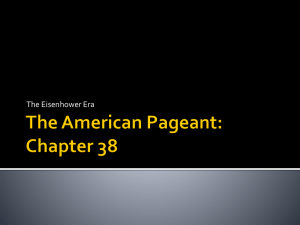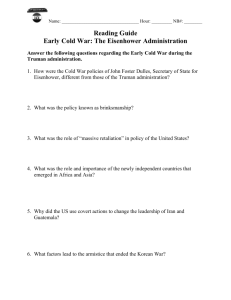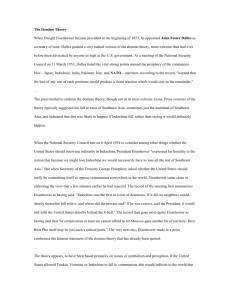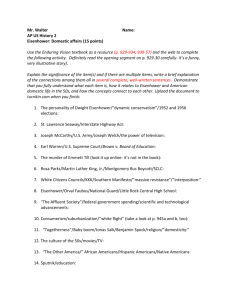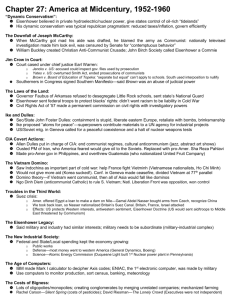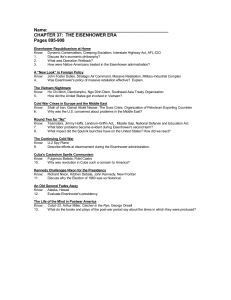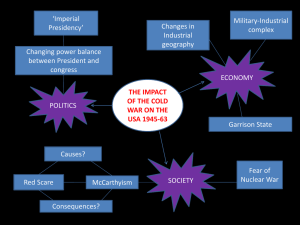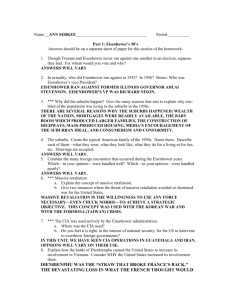Vietnam Unit Lesson #2
advertisement
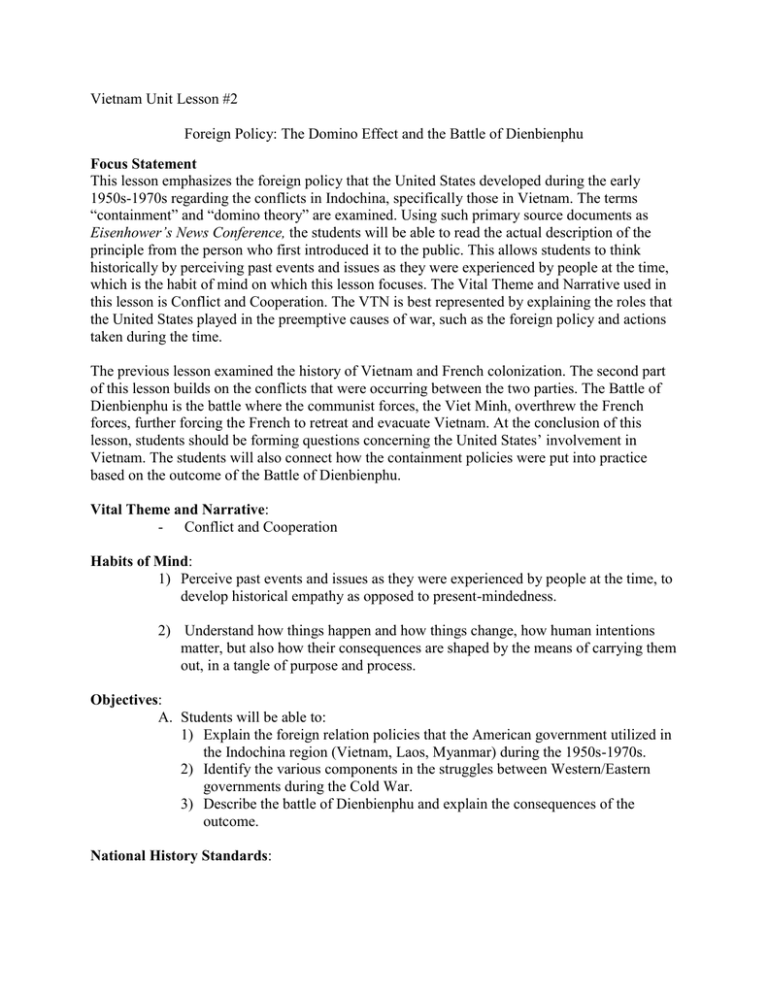
Vietnam Unit Lesson #2 Foreign Policy: The Domino Effect and the Battle of Dienbienphu Focus Statement This lesson emphasizes the foreign policy that the United States developed during the early 1950s-1970s regarding the conflicts in Indochina, specifically those in Vietnam. The terms “containment” and “domino theory” are examined. Using such primary source documents as Eisenhower’s News Conference, the students will be able to read the actual description of the principle from the person who first introduced it to the public. This allows students to think historically by perceiving past events and issues as they were experienced by people at the time, which is the habit of mind on which this lesson focuses. The Vital Theme and Narrative used in this lesson is Conflict and Cooperation. The VTN is best represented by explaining the roles that the United States played in the preemptive causes of war, such as the foreign policy and actions taken during the time. The previous lesson examined the history of Vietnam and French colonization. The second part of this lesson builds on the conflicts that were occurring between the two parties. The Battle of Dienbienphu is the battle where the communist forces, the Viet Minh, overthrew the French forces, further forcing the French to retreat and evacuate Vietnam. At the conclusion of this lesson, students should be forming questions concerning the United States’ involvement in Vietnam. The students will also connect how the containment policies were put into practice based on the outcome of the Battle of Dienbienphu. Vital Theme and Narrative: - Conflict and Cooperation Habits of Mind: 1) Perceive past events and issues as they were experienced by people at the time, to develop historical empathy as opposed to present-mindedness. 2) Understand how things happen and how things change, how human intentions matter, but also how their consequences are shaped by the means of carrying them out, in a tangle of purpose and process. Objectives: A. Students will be able to: 1) Explain the foreign relation policies that the American government utilized in the Indochina region (Vietnam, Laos, Myanmar) during the 1950s-1970s. 2) Identify the various components in the struggles between Western/Eastern governments during the Cold War. 3) Describe the battle of Dienbienphu and explain the consequences of the outcome. National History Standards: USH Era 9 Standard 2A Explain the rationale, implementation, and effectiveness of the U.S. containment policy. [Evaluate the implementation of a decision] Historical Thinking Standard 3C Analyze cause-and-effect relationships bearing in mind multiple causation including (a) the importance of the individual in history; (b) the influence of ideas, human interests, and beliefs; and (c) the role of chance, the accidental and the irrational. Procedures: A. Introduction - Review with students the components of the Cold War. Which countries are involved? What were the motives behind each country? How were communism and democracy viewed by the world? America? Africa? Europe? Indochina? - Display the following exchange between a news reporter and President Dwight D. Eisenhower. Ask students to read the exchange and underline the key words in Eisenhower’s explanation of Indochina’s strategic importance to the United States. - Robert Richards, Copley Press: "Mr. President, would you mind commenting on the strategic importance of Indochina to the free world? I think there has been, across the country, some lack of understanding on just what it means to us." President: "First of all, you have the specific value of a locality in its production of materials that the world needs. Then you have the possibility that many human beings pass under a dictatorship that is inimical to the free world. Finally, you have broader considerations that might follow what you would call the 'falling domino' principle. You have a row of dominoes set up, you knock over the first one, and what will happen to the last one is the certainty that it will go over very quickly. So you could have a beginning of a disintegration that would have the most profound influences.” - B. “President Eisenhower’s News Conference” - Pose the following question: How did the United States react toward the Cold War in Indochina? Pass out the document titled “President Eisenhower’s News Conference.” Using the sourcing and corroboration heuristics, ask students when this news conference took place, who was the author, and what events took place during the time period. Students should recognize that it took place during the 1950s and the early stages of the Cold War and keep in mind the Battle of Dienbienphu. - Students will complete the document analysis guide which is provided so that they can be guided with the reading and also organize the material. After 10 minutes, discuss the analysis guide and de-brief the News Conference. - Ask students to define the “Domino Theory” on the board and ask students to illustrate/role play the definition. (If necessary, prompt students to portray Indochinese nations, with each nation represented by a sign. One student will represent Russia or China and trigger (by tapping) students who each represent Laos, Vietnam, Indonesia, Myanmar, etc. Explain to the class that the Domino Theory played a major role in United States foreign policy; they wanted to end the spread of communism by preventing each nation (domino) from being exposed to communism. Ask students to speculate how reporters, foreign policy makers, the American public, and other nations might react to Eisenhower’s domino principle. What evidence supported Eisenhower’s explanation? What evidence challenged his domino principle? C) Battle of Dienbienphu - Review major events in Vietnam immediately after World War II. Who were the leaders and forces? (Vietnamese Viet Minh communist revolutionary forces and the colonial French forces.) What were their goals? - - Emphasize that French forces were attempting to build a blockade that would cut-off Viet Minh supplies to Laos, the country which neighbors Vietnam to the west. The Viet Minh reacted by surrounding and attacking the French forces. - Pass out the “Battle of Dienbienphu” handout, which shows the location of the battle and also details the key events that influenced the battle. Use the handout to have students return to an analysis of Eisenhower’s press conference comments to provide further contextualization. - Outcome: French forces evacuated and surrendered. The Viet Minh won the battle. This led to the 1954 Geneva Accords which granted Indochinese countries independence from French rule. Conflict occurred in Vietnam because the majority of the northern region favored communistic Viet Minh, whereas in the southern region, aside from the Vietcong, people opposed communist rule. D) Closing Activity Students choose one of the following: (1) write a short response to the following statement: The domino theory justified and expanded United States involvement in Vietnam. (2) Draw a political cartoon that supports or challenges the domino theory. Methods of Assessment: - Writing/political cartoon activity described in the Closing Activity. Materials: 1) President Eisenhower's News Conference, April 7, 1954, Public Papers of the Presidents, 1954 2) Primary Source Analysis Guide 3) “Battle of Dienbienphu” handout President Eisenhower's News Conference, April 7, 1954, Public Papers of the Presidents, 1954 Q. Robert Richards, Copley Press: "Mr. President, would you mind commenting on the strategic importance of Indochina to the free world? I think there has been, across the country, some lack of understanding on just what it means to us." THE PRESIDENT: "You have, of course, both the specific and the general when you talk about such things. "First of all, you have the specific value of a locality in its production of materials that the world needs. "Then you have the possibility that many human beings pass under a dictatorship that is inimical to the free world. "Finally, you have broader considerations that might follow what you would call the 'falling domino' principle. You have a row of dominoes set up, you knock over the first one, and what will happen to the last one is the certainty that it will go over very quickly. So you could have a beginning of a disintegration that would have the most profound influences. "Now, with respect to the first one, two of the items from this particular area that the world uses are tin and tungsten. They are very important. There are others, of course, the rubber plantations and so on. "Then with respect to more people passing under this domination, Asia, after all, has already lost some 450 million of its peoples to the Communist dictatorship, and we simply can't afford greater losses. "But when we come to the possible sequence of events, the loss of Indochina, of Burma, of Thailand, of the Peninsula, and Indonesia following, now you begin to talk about areas that not only multiply the disadvantages that you would suffer through loss of materials, sources of materials, but now you are talking really about millions and millions and millions of people. "Finally, the geographical position achieved thereby does many things. It turns the so-called island defensive chain of Japan, Formosa, of the Philippines and to the southward; it moves in to threaten Australia and New Zealand. "It takes away, in its economic aspects, that region that Japan must have as a trading area or Japan, in turn, will have only one place in the world to go- that is, toward the Communist areas in order to live. "So, the possible consequences of the loss are just incalculable to the free world.” Name_____________________________________________________ Period _______ President Eisenhower's News Conference Analysis Guide Directions: Answer the following questions that correspond with President Eisenhower’s News Conference. A. Identifying the Document 1) When was this document written? 2) What do you know about this time period? Describe events in the United States and the world. 3) Who is the author of this document? What do you know about this individual? B. Analyzing the Document 4) In your own words, rewrite the question the reporter asks Eisenhower. 5) In your own words, define the term “free world.” 6) How does President Eisenhower respond to the question? What are the two ways he explains the issue? 7) Describe the “falling domino” principle.” How does it work? 8) According to Eisenhower, what are the consequences and effects of the “falling domino” principle? 9) Suppose you were at the News Conference. What questions would you would ask Eisenhower after listening to his response on the issue of Indochina? C. Determining the Historical Context 10) How can neighboring nations influence a country’s economic policies, political policies, and culture? [Recommended Picture to insert: http://www.time.com /time/covers/ 0,16641,19530928,00 .html ] Works Cited “Dien Bien Phu zoom.” Map. 2006. From Wikimedia Commons. http://commons.wikimedia.org/wiki/File:Dien_Bien_Phu_zoom.svg (accessed 23, 2009). November “General Vo Nguyen Giap.” Photograph. 2006. From Wikimedia Commons. http://commons.wikimedia.org/wiki/File:General_Vo_Nguyen_Giap.jpg (accessed November 23, 2009). NgaViet, artist. “Map of Vietnam Provinces.” Map. 2009. From Wikimedia Commons. http://en.wikipedia.org/wiki/File:Map-of-Vietnam-Provinces.svg (accessed November 23, 2009). Pellegrini, Mark, artist. “Battle of Dien Bien Phu.” Map. 2009. From Wikimedia Commons. http://en.wikipedia.org/wiki/File:Battle_of_Dien_Bien_Phu_map.png (accessed November 23, 2009).
